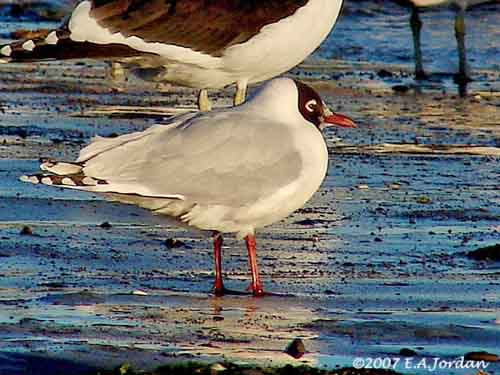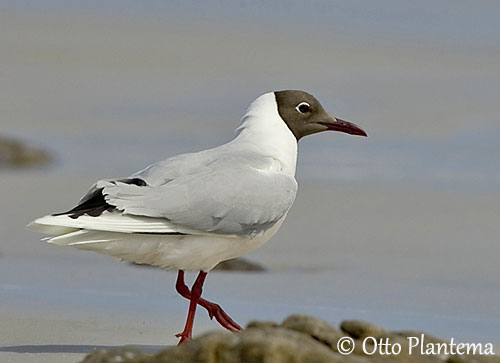
Fr: Mouette de Patagonie
All: Patagonienmöwe
Esp: Gaviota Cahuil, Gaviota cáhuil, Gaviota capucho café, Gaviota Capuchón Café
Ita: Gabbiano capobruno
Nd: Patagonische Kokmeeuw
Sd: Sydamerikansk skrattmås
Port: Gaivota-maria-velha
Photographers:
John Anderson
John Anderson Photo Galleries
Eduardo Andrés Jordan
MIS AVES – AVES DE ARGENTINA
Otto Plantema
Trips around the world
Text by Nicole Bouglouan
Sources:
HANDBOOK OF THE BIRDS OF THE WORLD Vol 3 by Josep del Hoyo-Andrew Elliott-Jordi Sargatal - Lynx Edicions - ISBN : 8487334202
BirdLife International (BirdLife International)
Birding Patagonia – Adventure expeditions
Wikipedia, la enciclopedia libre
Brown-hooded Gull
Chroicocephalus maculipennis
Charadriiformes Order – Laridae Family
INTRODUCTION:
The Brown-hooded Gull is a small hooded gull present on S South American coasts and in the Falklands. It is sometimes treated as a subspecies of the Black-headed Gull (Chroicocephalus ridibundus) in the family Laridae. Both species are very similar.
The Brown-hooded Gull is the least numerous of the Falklands’ gulls. Its local name is Pink-breasted Gull.
DESCRIPTION OF THE BIRD:
Biometrics:
Length: 35-37 cm
Weight: 290-360 g
The adult in breeding plumage has white neck and underparts, sometimes with pale pink wash on breast, flanks and belly.
On the upperparts, back and upperwings are pale grey, whereas rump, uppertail-coverts and tail are white. On the upperwings, the outer primaries are white with black-tipped outermost primaries. On the underwing, the primaries are black with conspicuous white triangle at wing tip, well visible in flight. The rest of the underwing is pale greyish.
The head is entirely chocolate-brown forming a hood.
The bill is dark red. The eyes are brown, with an incomplete white eyering. Legs and feet are orange-red.

The non-breeding adult has white head with some black spots in the eye’s area, and also auricular spot. Bill and legs are duller.
Both sexes are similar.
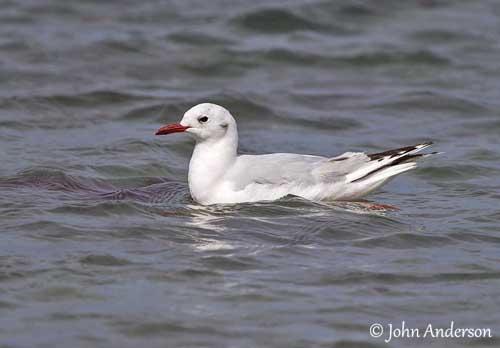
The juvenile has mottled brown head, back and wings. We can see a narrow black trailing edge and a narrow, black subterminal bar on the tail. The bill is brownish-black. Legs and feet are pinkish-brown.
RANGE:
The Brown-hooded Gull is found in S South America, from SC Chile and Uruguay, S to Tierra del Fuego, and in the Falklands. It is probably present in SE Brazil too.
It usually winters to N Chile and CE Brazil.
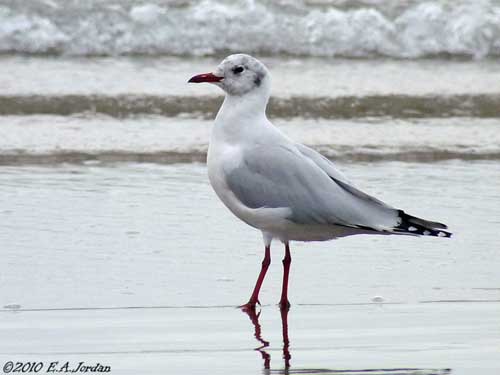
HABITAT:
The Brown-hooded Gull is usually found along the seacoasts, but it also frequents ponds, rivers, lakes and marshes. It can be seen in cultivated open fields where it follows the ploughs, like it follows the fishing boats at sea.
It breeds on both freshwater and brackish lakes and marshes with emergent vegetation. However, they may also breed on rocky headlands and higher, on shingle beaches, and among rushes at lakes and rivers, in the vicinity of the sea.
In the Falklands, it breeds on remote coastal plains in mixed gull species colonies.
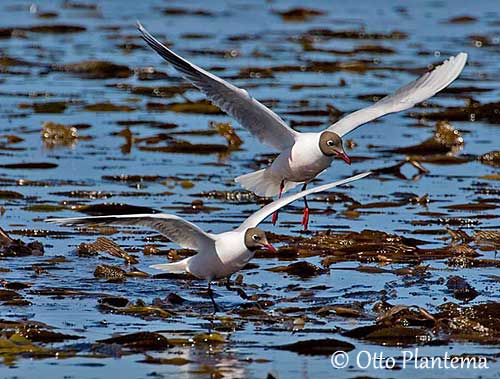
CALLS AND SONGS: SOUNDS BY XENO-CANTO
The Brown-hooded Gull is noisy during the breeding season and while feeding and migrating, like numerous Laridae.
They are gregarious and highly social birds with well-developed communication.
The calls include harsh croaking and screaming notes. Calls and songs accompany ritual and visual displays.
BEHAVIOUR IN THE WILD:
The Brown-hooded Gull feeds primarily on animal food, both marine and terrestrial. When feeding in the water, it takes small fish, molluscs and crustaceans. On land, it feeds on earthworms and insects. It can take carrion and offal when available.
It often follows the ploughs in cultivated areas where it consumes numerous invertebrates, including Lepidoptera and parasitic insects. For this reason, this species is usually protected by the farmers.
It is known for stealing food from other bird species too.
In the Falklands, the Brown-hooded Gull feeds on numerous marine invertebrates and small fish.
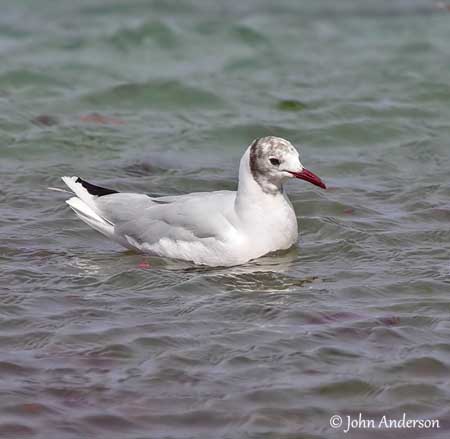
It catches them directly from the water surface, often around the kelp beds. It forages along the shores, as well at sea as at lakes, ponds and marshes.
The Brown-hooded Gull nests in colonies of 10-50 pairs, sometimes up to 500 nests. The location of these colonies usually changes every year, according to food resources and suitable nesting site availability.
They often nest with other bird species. In the Falklands, they nest close to South-American Terns and Dolphin Gulls.
The courtship displays are not described, but they are probably fairly similar to those of numerous Laridae- courtship displays, and accompanied by loud calls.
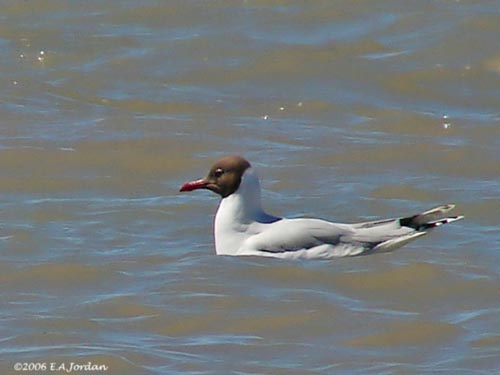
The Brown-hooded Gull usually disperses after the breeding season. It may move N, to the coasts of N Chile and C Brazil. They can be seen on coastal areas and large rivers during winter.
The flight is fast and powerful. Gulls are agile fliers.
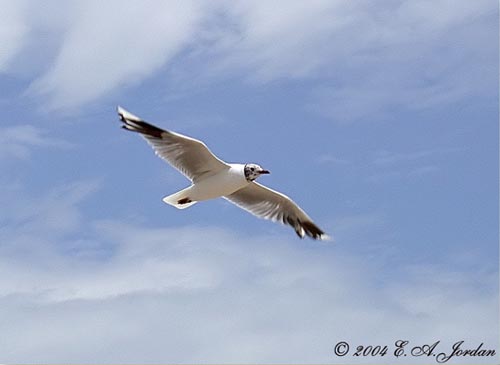
REPRODUCTION OF THIS SPECIES:
The laying takes place between November and December in Chile, between late October and early January in Argentina, and in late December or early January in Falkland Islands.
The colonies are established among aquatic vegetation, at the edges of lakes, ponds or marshes, on shingle beaches or rocky headlands, and in remote coastal plains in the Falklands where the nest is a hollow lined with vegetation.
On the continent, the nest can be a floating platform made with aquatic vegetation, or a bulky grass structure on dry ground.
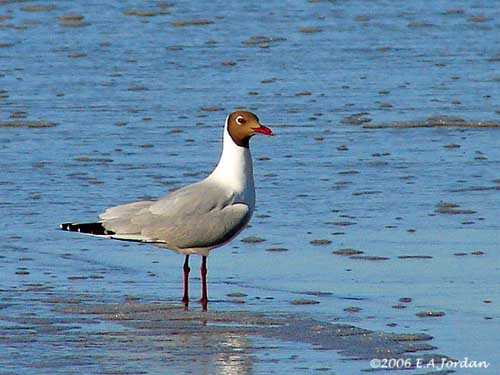
The female lays 2-4 olive-brown eggs with rufous and greyish markings. The duration of the incubation is unknown, but we can suggest that both parents incubate during 22-26 days, like in similar species. At hatching, the chicks are fed by the adults. If not disturbed, they remain on the nest, brooded and guarded by the female, while the male provides food. The juveniles remain near the nest-site until they fledge. This period is unknown but ranges between 4 and 7 weeks after hatching.
However, the chicks are able to go into the water only a few hours after hatching if they are threatened by intruders or predators.
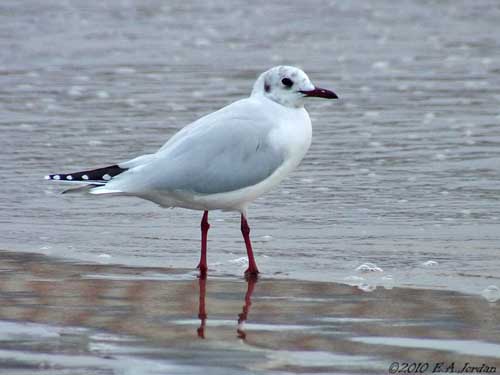
PROTECTION / THREATS / STATUS:
The Brown-hooded Gull has large range and its population is increasing, but the size is unknown. However, the Falkland’s population is estimated at about 2,000 breeding pairs.
This species is not currently threatened and evaluated as Least Concern.
